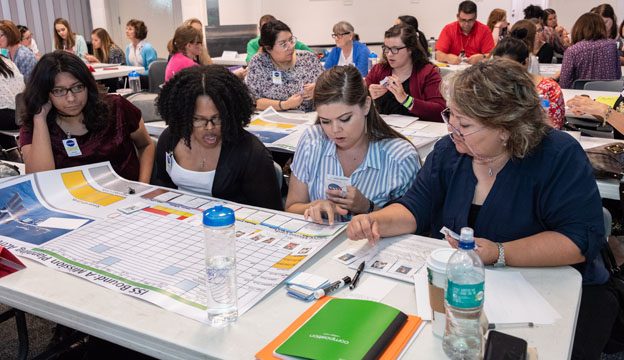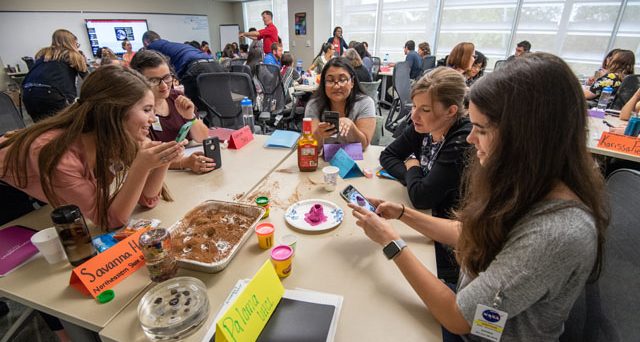Integrating STEM Into Your Curriculum

I have been in contact with a number of school districts and STEM Specialists lately that are struggling with the same issues. Teachers are unsure how to add STEM into their already crowded curriculum and teachers are uncomfortable with their current understanding of STEM in relationship to doing science in their classrooms. There remains a stigma around what STEM is and more specifically, what science is, and whether or how these things can be implemented in the K-12 setting.
In early elementary, standardized tests focus on English and Math, therefore, the districts also want teachers focused in those areas. The thinking is, if that is what the states are evaluating, it must be what is important. What happens then, is students are reaching the 5th grade with little or no background in science and at that point, teachers are expected to catch students up on the skills included on that year’s battery of tests. This is like deciding to start saving for retirement on your 63rd birthday.
Students need to be engaged in science, critical thinking, problem based, inquiry based, and STEM design challenges from early on. The skills developed and honed in these areas will bring together the whole student. Walking, for example, is not an isolated skill. Search for “robot walking” to see just how complex a thing it is to walk bipedally. Balance, motor function, body geometry, computing trajectories, these are just a few of the things we do unconsciously to get from A to B. Why do we assume reading, or math computation to be any different?
In my last blog, I talked about the importance of using story in your STEM curriculum to add context to the content. The same goes the other direction. Asking students to write about nonsense ideas, random vocabulary words for memorization, or assigning math problem sets to complete by rote are demonstrably least effective way to engage your students. Math equations in context are finished with much understanding and the results far more meaningful and therefore, more firmly rooted in long-term memory with more factors to help call up the information later when tested. Stories and vocabulary rooted in experience share the same benefit of being multimodal, and appealing to concrete and abstract thinkers alike.
The pressures of state sponsored testing are great and the stakes are high for school systems. So much so, that in desperation, I have even recently heard of administrators specifically demanding less hands on activities in favor of the old fashioned “Sage on the Stage” lecture/notetaking paradigm in hopes of getting all of the right information in front of students. This is happening even though there are mountains of literature and studies telling us the inefficacy of such practices. Students are no longer whole people to be educated, rather, they have become number generators or point givers for the magical spreadsheet that somehow determines whether our jobs are safe or not.
Using STEM activities and teaching science as a verb, a thing one does to understand the world around us from the very beginning of the educational process is key to truly preparing students for the tomorrow they will inhabit. These activities do not work in isolation either, but as part of the ELA, Social Studies, and/or Math curriculum. Integrated concepts that are engaging, explored, explained, and elaborated upon create learning environments that truly prepare students for the challenges ahead, including standardized testing.
 NASA has the resources to help teachers and school systems incorporate and integrate truly engaging student activities into your curriculum. We can provide the professional development that will make teachers feel more secure in their own ability to understand and implement whole student programs that include science and STEM into their classroom models. If you are ready to create a program that helps students prepare for a future in which the sky is most definitely NOT the limit, contact us and let us help you today. My colleagues and I are at your disposal. We provide live free webinars, short course badging, and face-to-face events tailored to the needs of teachers and informal educators. We are the NASA STEM Educator Professional Development Collaborative. Check us out online at: https://www.txstate-epdc.net/ and let us be a part of your professional development.
NASA has the resources to help teachers and school systems incorporate and integrate truly engaging student activities into your curriculum. We can provide the professional development that will make teachers feel more secure in their own ability to understand and implement whole student programs that include science and STEM into their classroom models. If you are ready to create a program that helps students prepare for a future in which the sky is most definitely NOT the limit, contact us and let us help you today. My colleagues and I are at your disposal. We provide live free webinars, short course badging, and face-to-face events tailored to the needs of teachers and informal educators. We are the NASA STEM Educator Professional Development Collaborative. Check us out online at: https://www.txstate-epdc.net/ and let us be a part of your professional development.
Steven Smith
Educator Professional Development Specialist, NASA STEM EPDC
Johnson Space Center
